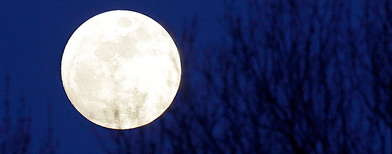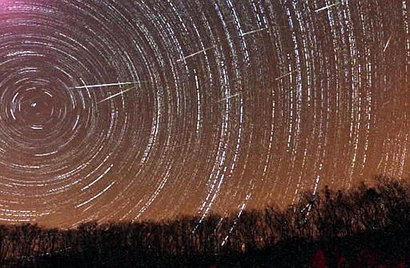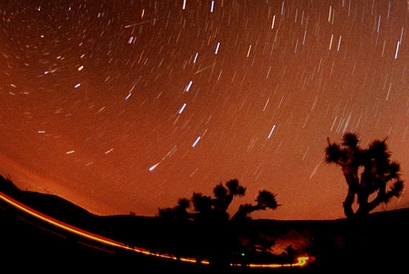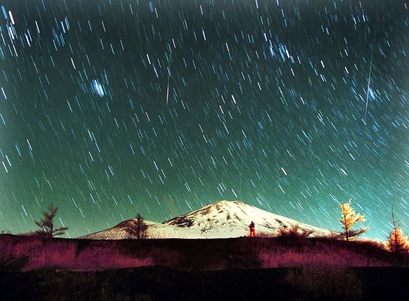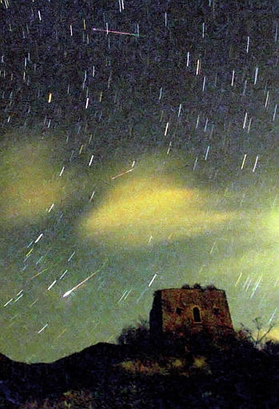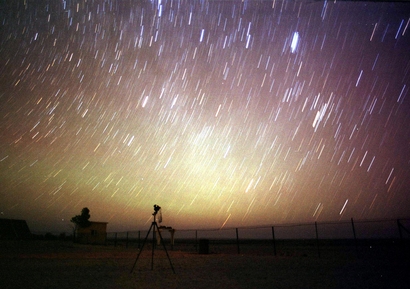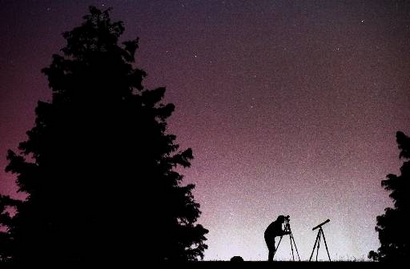From Space.com:
Yahoo! Buzz
The 12 Stages of Monday's Total Lunar Eclipse
By Joe Rao
SPACE.com Skywatching Columnist
posted: 19 December 2010
10:25 am ET
No enthusiastic sky watcher ever misses a total eclipse of the moon. The spectacle is often more beautiful and interesting than one would think. To prepare for the rare event on Dec. 20-21, here are some tips to keep in mind.
During the time that the moon is entering into, and later emerging from, the Earth's shadow, secondary phenomena may be overlooked. Below we describe 12 stages of a total lunar eclipse. [Lunar Eclipse Viewing Guide]
Amazing Spectacle: Total Lunar Eclipse Monday Night
By Joe Rao
SPACE.com Skywatching Columnist
posted: 17 December 2010
11:09 am ET
For a few hours on the night of Dec. 20 to Dec. 21, the attention of tens of millions of people will be drawn skyward, where the mottled, coppery globe of our moon will hang completely immersed in the long, tapering cone of shadow cast out into space by our Earth. If the weather is clear, favorably placed skywatchers will have a view of one of nature's most beautiful spectacles: a total eclipse of the moon.
Unlike a total eclipse of the sun, which is only visible to those in the path of totality, eclipses of the moon can usually be observed from one's own backyard. The passage of the moon through the Earth's shadow is equally visible from all places within the hemisphere where the moon is above the horizon.
The total phase of the upcoming event will be visible across all of North and South America, as well as the northern and western part of Europe, and a small part of northeast Asia, including Korea and much of Japan. Totality will also be visible in its entirety from the North Island of New Zealand and Hawaii — a potential viewing audience of about 1.5 billion people. This will be the first opportunity from any place on earth to see the moon undergo a total eclipse in 34 months. [Amazing photos of a total lunar eclipse]
Ads by GoogleMoon Eclipse Video ClipSearch multiple engines for moon eclipse video clip
www.webcrawler.comSatellite EarthGet Satellite Maps, Aerial Photos & More With The Free Maps Appbar
Maps.alot.comDanica Patrick Honda FilmDiscover the upside of failure from Honda racers and engineers.
www.honda.comThis star chart shows where in the sky the upcoming lunar eclipse will appear. And check this NASA lunar eclipse chart to see how visible the eclipse will be from different regions around the world.
Stages of the eclipse
There is nothing complicated about viewing this celestial spectacle. Unlike an eclipse of the sun, which necessitates special viewing precautions in order to avoid eye damage, an eclipse of the moon is perfectly safe to watch. All you'll need to watch are your eyes, but binoculars or a telescope will give a much nicer view.
The eclipse will actually begin when the moon enters the faint outer portion, or penumbra, of the Earth's shadow a little over an hour before it begins moving into the umbra. The penumbra, however, is all but invisible to the eye until the moon becomes deeply immersed in it. Sharp-eyed viewers may get their first glimpse of the penumbra as a faint smudge on the left part of the moon's disk at or around 6:15 UT (on Dec. 21) which corresponds to 1:15 a.m. Eastern Time or 10:15 p.m. Pacific Time (on Dec. 20).
The most noticeable part of this eclipse will come when the moon begins to enter the Earth's dark inner shadow (called the umbra). A small scallop of darkness will begin to appear on the moon's left edge at 6:33 UT (on Dec. 21) corresponding to 1:33 a.m. EST or 10:33 p.m. PST (on Dec. 20).
The moon is expected to take 3 hours and 28 minutes to pass completely through the umbra.
The total phase of the eclipse will last 72 minutes beginning at 7:41 UT (on Dec. 21), corresponding to 2:41 a.m. EST or 11:41 p.m. PST (on Dec. 20).
At the moment of mid-totality (8:17 UT/3:17 a.m. EST/12:17 a.m. PST), the moon will stand directly overhead from a point in the North Pacific Ocean about 800 miles (1,300 km) west of La Paz, Mexico.
The moon will pass entirely out of the Earth's umbra at 10:01 UT/5:01 a.m. EST/2:01 a.m. PST and the last evidence of the penumbra should vanish about 15 or 20 minutes later.
Color and brightness in question
During totality, although the moon will be entirely immersed in the Earth's shadow, it likely will not disappear from sight. Rather, it should appear to turn a coppery red color, a change caused by the Earth's atmosphere bending or refracting sunlight into the shadow.
Since the Earth's shadow is cone-shaped and extends out into space for about 844,000 miles (1,358,000 km), sunlight will be strained through a sort of "double sunset," all around the rim of the Earth, into its shadow and then onto the moon.
However, because of the recent eruptions of the Eyjafjallajökull volcano last spring and the Merapi volcano in Indonesia in October, one and possibly even two clouds of ash and dust might be floating high above the Earth. As a result, the moon may appear darker than usual during this eclipse; during totality, parts of the moon might even become black and invisible.
A careful description of the colors seen on the totally eclipsed moon and their changes is valuable. The hues depend on the optical equipment used, usually appearing more vivid with the naked eye than in telescopes. The French astronomer Andre-Louis Danjon introduced the following five-point scale of lunar luminosity ("L") to classify eclipses:
L = 0: Very dark eclipse, moon almost invisible, especially in mid-totality.
L = 1: Dark eclipse, gray or brownish coloration, details distinguishable only with difficulty.
L = 2: Deep red or rust-colored eclipse, with a very dark central part in the shadow, and outer edge of the umbra relatively bright.
L = 3: Brick red eclipse, usually with a bright or yellow rim to the shadow.
L = 4: Very bright copper-red or orange eclipse, with a bluish very bright shadow rim.
Examine the moon at mid-totality and also near the beginning and end of totality to get an impression of both the inner and outer umbra. In noting an L observation, state the time and optical means (naked eye, binoculars or telescope) that is used. We invite readers to e-mail their Danjon estimate for this eclipse (along with any pictures they'd like to share) to cmoskowitz-at-SPACE.com.
At mid-totality, from rural locations far from city lights, the darkness of the sky is impressive. Faint stars and the Milky Way will appear, and the surrounding landscape will take on a somber hue. As totality ends, the eastern edge of the moon begins to emerge from the umbra, and the sequence of events repeats in reverse order until the spectacle is over.
Fringe effects
Interestingly, from most of New Zealand, a slice of northeast Australia, Papua, New Guinea, southwest Japan and Korea, the moon will rise during totality on the evening of Dec. 21. Because of low altitude and bright evening twilight, observers in these locations may not see much of the moon at all until it begins to emerge from out of the Earth's shadow.
Conversely, much of the United Kingdom and parts of western and northern Europe will see the moon set during totality on the morning of Dec. 21. Because of low altitude and bright morning twilight, observers in these locations may not see much of the moon at all after it slips completely into the Earth's shadow.
Past and future
The last total lunar eclipse occurred on Feb. 20 to Feb. 21, 2008 and was visible from most of the Americas, as well as Europe, much of Africa and western Asia. In 2011, there will be two total lunar eclipses. The first, on June 15, will be visible primarily from the Eastern Hemisphere and will have an unusually long duration of totality lasting one hour and 40 minutes.
Another total lunar eclipse will occur on Dec. 10 and will be visible over the western half of North America before moonset. For the next total lunar eclipse that will be visible across all of North America, we must wait until April 14 to April 15, 2014.
Probably not all of those mentioned will occur because no two eclipses are exactly the same. But many will, and those who know what to look for have a better chance of seeing them! [Amazing photos of a total lunar eclipse]
Ads by GoogleMoon Eclipse Video ClipSearch multiple engines for moon eclipse video clip
www.webcrawler.comFree Space WallpapersGet Cool Space Desktop Wallpapers w Planets, Moons & Stars-Try Them Now
wallpapers.smileycentral.comDanica Patrick Honda FilmDiscover the upside of failure from Honda racers and engineers.
www.honda.comClick here for a table showing the times of all 12 stages in different time zones. This star chart shows where in the sky the upcoming lunar eclipse will appear.
The various stages, fully described:
1) Moon enters penumbra (12:29 a.m. EST/9:29 p.m. PST) The shadow cone of the earth has two parts: a dark, inner umbra, surrounded by a lighter penumbra. The penumbra is the pale outer portion of the Earth's shadow. Although the eclipse begins officially at this moment, this is in essence an academic event. You won't see anything unusual happening to the moon - at least not just yet.
The Earth's penumbral shadow is so faint that it remains invisible until the moon is deeply immersed in it. We must wait until the penumbra has reached roughly 70 percent across the moon's disk. For about the next 45 minutes the full moon will continue to appear to shine normally although with each passing minute it is progressing ever deeper into the Earth's outer shadow.
2) Penumbral shadow begins to appear (1:13 a.m. EST/10:13 p.m. PST) Now the moon has progressed far enough into the penumbra so that it should be evident on its disk. Start looking for a very subtle light shading to appear on the moon's upper left portion. This will become increasingly more and more evident as the minutes pass; the shading will appear to spread and deepen. Just before the moon begins to enter the Earth's dark umbral shadow the penumbra should appear as an obvious smudge or tarnish on the moon's left portion.
3) Moon enters umbra (1:33 a.m. EST/10:33 p.m. PST) The moon now begins to cross into the Earth's dark central shadow, called the umbra. A small dark scallop begins to appear on the moon's upper left-hand (northeastern) limb. The partial phases of the eclipse begin; the pace quickens and the change is dramatic. The umbra is much darker than the penumbra and fairly sharp-edged.
As the minutes pass the dark shadow appears to slowly creep across the moon's face. At first the moon's limb may seem to vanish completely inside of the umbra, but much later, as it moves in deeper you'll probably notice it glowing dimly orange, red or brown. Notice also that the edge of the Earth's shadow projected on the moon is curved. Here is visible evidence that the Earth is a sphere, as deduced by Aristotle from Iunar eclipses he observed in the 4th century B.C.
Almost as if a dimmer switch was slowly being turned down, the surrounding landscape and deep shadows of a brilliant moonlit night begin to fade away.
4) 75 percent coverage (2:23 a.m. EST/11:23 p.m. EST) With three-quarters of the moon's disk now eclipsed, that part of it that is immersed in shadow should begin to very faintly light up similar to a piece of iron heated to the point where it just begins to glow. It now becomes obvious that the umbral shadow is not complete darkness. Using binoculars or a telescope, its outer part is usually light enough to reveal lunar seas and craters, but the central part is much darker, and sometimes no surface features are recognizable.
Colors in the umbra vary greatly from one eclipse to the next. Reds and grays usually predominate, but sometimes browns, blues and other tints are encountered.
5) Less than five minutes to totality (2:37 a.m. EST/11:37 p.m. PST) Several minutes before (and after) totality, the contrast between the remaining pale-yellow sliver and the ruddy-brown coloration spread over the rest of the moon's disk may produce a beautiful phenomenon known to some as the "Japanese lantern effect. "
6) Total eclipse begins (2:41 a.m. EST/11:41 p.m. PST) When the last of the moon enters the umbra, the total eclipse begins. How the moon will appear during totality is not known. Some eclipses are such a dark gray-black that the moon nearly vanishes from view. During other eclipses it can glow a bright orange.
The reason the moon can be seen at all when totally eclipsed is that sunlight is scattered and refracted around the edge of the Earth by our atmosphere. To an astronaut standing on the moon during totality, the sun would be hidden behind a dark Earth outlined by a brilliant red ring consisting of all the world's sunrises and sunsets.
The brightness of this ring around the earth depends on global weather conditions and the amount of dust suspended in the air. A clear atmosphere on Earth means a bright lunar eclipse. If a major volcanic eruption has injected particles into the stratosphere, the eclipse is very dark.
Because of the recent eruptions of the Eyjafjallajökull volcano in Iceland last spring and the Merapi volcano in Indonesia in October, one and possibly two clouds of ash and dust might be currently floating high above the Earth. As a result, the moon may appear darker than usual during this eclipse; during totality, parts of the moon might even become black and invisible.
7) Middle of totality (3:17 a.m. EST/12:17 a.m. PST)The moon is now shining anywhere from 10,000 to 100,000 times fainter than it was just a couple of hours ago.
Since the moon is moving to the north of the center of the Earth's umbra, the gradation of color and brightness across the lunar disk should be such that its lower portion should appear darkest, with hues of deep copper or chocolate brown. Meanwhile, its upper portion – that part of the moon closest to the outer edge of the umbra should appear brightest, with hues of reds, oranges and even perhaps a soft bluish-white.
Observers away from bright city lights will notice a much greater number of stars than were visible earlier in the night. The darkened moon will be near the constellation Taurus, just beyond the tips of the bull's horns and hovering high above the stars of Orion, the hunter.
The darkness of the sky is impressive. The surrounding landscape has taken on a somber hue. Before the eclipse, the full moon looked flat and one-dimensional. During totality, however, it will look smaller and three-dimensional – like some weirdly illuminated ball suspended in space.
Before the moon entered the Earth's shadow, the temperature at the lunar equator on its sunlit surface hovered at 260 degrees F (127 degrees C). Since the moon lacks an atmosphere, there is no way that this heat could be retained from escaping into space as the shadow sweeps by.
Now, in shadow, the temperature on the moon has plummeted to minus 280 degrees F (minus 173 degrees C). A drop of over 500 degrees F (300 degrees C) in only about two hours!
8) Total eclipse ends (3:53 a.m. EST/12:53 am. PST) The emergence of the moon from the shadow begins. The first small segment of the moon begins to reappear, followed again for the next several minutes by the Japanese Lantern Effect.
9) 75 percent coverage (4:10 a.m. EST/1:10 a.m. PST) Any vestiges of coloration within the umbra should be disappearing now. From here on out, as the dark shadow methodically creeps off the moon's disk it should appear black and featureless.
10) Moon leaves umbra (5:01 a.m. EST/2:01 a.m. PST) The dark central shadow clears the moon's upper right hand (northwestern) limb.
11) Penumbra shadow fades away (5:20 a.m. EST/2:20 p.m. PST) As the last, faint shading vanishes off the moon's upper right portion, the visual show comes to an end.
12) Moon leaves penumbra (6:04 a.m. EST/3:04 p.m. PST) The eclipse officially ends, as the moon is completely free of the penumbral shadow.





















